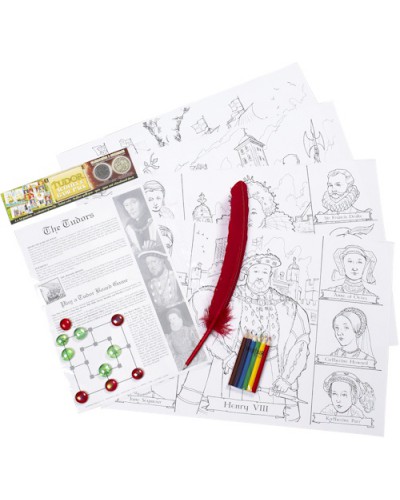Product Description: The Tudor Activity & Game Pack consists of four A3 size colouring sheets, six colouring pencils and a Tudor factsheet with board game and glass beads. Also supplied is a quill pen and a Tudor coin attached to the header card.
The colouring posters include an image of Henry VIII and his six wives, two knights in a jousting battle, Elizabeth I and six important Elizabethan figures and a poster depicting the attack of the Spanish Armada. The factsheet, with images, and game board explains about the Tudors, the Tudor alphabet, Tudor coins, prices and wages and a quiz. The game board on the sheet together with the provided glass beads is used to play a Tudor game, called Five Men’s Morris. There is a colourful header card that has pictures showing how the posters could be coloured in and has a Tudor coin attached. On the header there is also information about the Tudors and Tudor England.
Information: Henry VIII succeeded his father Henry VII to the throne in 1509, as his older brother had died, aged 16, leaving Henry free to marry his widow Catherine of Aragon. Their first child, a boy, survived just a month and the lack of a male heir set a pattern of insecurity in Henry’s reign which resulted in his many marriages and England breaking away from the Catholic Church in Rome. Henry divorced Catherine of Aragon and Anne of Cleves, Jane Seymour, (mother of his only surviving male heir and understood to be Henry’s favourite), died after childbirth and both Anne Boleyn (the mother of Elizabeth I) and Catherine Howard were beheaded. His last wife, Katherine Parr survived Henry when he died in 1547.
The last Tudor Monarch, Elizabeth I was only 25 when she became Queen in 1558, succeeding her elder half-sister Mary I. Her reign, in which England became an important European power, is often referred to as ‘The Golden Age’. Trade, exploration and the Arts flourished – Sir Francis Drake circumnavigated the world in his ship, ‘The Golden Hind’; Sir Walter Raleigh established England’s first colonies in North America and the plays of William Shakespeare provided a lasting artistic legacy.
On 28 May 1588, the Spanish Armada, sent by Philip II of Spain, set sail from Lisbon, heading for the English Channel. Angered by the execution of the Catholic Mary Queen of Scots, Philip was determined to invade England, overthrow Elizabeth and restore Catholicism to the country, as his former wife Mary I had done briefly. It was attacked and defeated by a fleet of 200 English ships led by Sir Francis Drake and Sir John Hawkins.
Five Men’s Morris is an abstract strategy board game for two players that emerged from the Roman Empire. The game is also known as Nine Man Morris, Mill, Mills, Merels, Merelles, and Merrills in English and was very popular during the medieval period.
There are many different variations of this game which include three, six, seven, nine, eleven and twelve men’s Morris. Games like this have been found carved into the cloister seats of English cathedrals at Canterbury, Gloucester, Norwich, Salisbury and Westminster Abbey. Another board is carved into the base of a pillar in Chester Cathedral. In Shakespeare’s 16th century work, A Midsummer Night’s Dream, titania laments that it is no longer played: “The nine men’s morris is filled up with mud” (Act II, Scene I).
The Tudor alphabet contained 24/25 letters, as opposed to the present day alphabet of 26 letters. The letters “u” and “v” were the same letter as were “i” and “j”. The “j” was usually used as the capital form of the “i”. The “u” was used only in the middle of a word, and the “v” was used at the beginning. The other difference was that there was another letter which resembled a “y” which was used to represent the “th” sound. So the word “the” was written in a similar way as “ye” would be in the present day. Some words were also spelt with and additional “e” at the end.
A popular currency during the time of the Tudors was Pounds, shillings and pence. The ‘£’ (a fancy L) is used for pound (from the Latin libra, meaning pound weight), the ‘s’ is used for shilling (taken from the Latin solidus, the name of a Roman coin) and ‘d’ is used for penny (from the Latin denarius another Roman coin name). There were other denominations of coins used like double sovereigns, half sovereigns, sixpences, groats, half groats and halfpennies.

